Plastic packaging has become an integral part of our daily lives, offering convenience and practicality. However, beneath its seemingly harmless exterior, plastic packaging harbors a range of disadvantages that have far-reaching implications for our environment, health, and economy. In this forum post, we will delve into the multifaceted drawbacks of plastic packaging, shedding light on its detrimental effects and exploring alternative solutions.
- Environmental Impact:
Plastic packaging poses a significant threat to our environment. Its production contributes to the depletion of fossil fuels and the emission of greenhouse gases. Moreover, plastic waste often ends up in landfills or pollutes our oceans, taking hundreds of years to decompose. This not only disrupts ecosystems but also harms marine life, as animals mistake plastic for food or become entangled in it. - Health Concerns:
Plastic packaging can also have adverse effects on human health. Certain types of plastics contain harmful chemicals, such as bisphenol A (BPA) and phthalates, which can leach into food and beverages. Prolonged exposure to these chemicals has been linked to various health issues, including hormonal disruptions, reproductive problems, and even certain types of cancer. Additionally, microplastics, tiny particles that result from the breakdown of larger plastic items, have been found in our food, water, and even the air we breathe, raising concerns about their potential health impacts. - Economic Implications:
While plastic packaging may seem cost-effective in the short term, it imposes significant economic burdens in the long run. The disposal and management of plastic waste require substantial resources and infrastructure. Governments and municipalities often bear the financial burden of waste management, diverting funds that could be allocated to other pressing needs. Additionally, the negative perception surrounding plastic packaging can lead to reputational damage for businesses, affecting consumer trust and loyalty. - Limited Recycling and Circular Economy:
Plastic packaging's recyclability is often overstated. In reality, only a fraction of plastic waste is effectively recycled due to various factors, including contamination, lack of proper recycling facilities, and the complexity of plastic composition. This limited recycling capacity perpetuates the linear "take-make-dispose" model, hindering the transition towards a circular economy. Without effective recycling and reuse systems, plastic packaging continues to contribute to the depletion of finite resources and the accumulation of waste.
Conclusion:
Plastic packaging, despite its convenience, presents a host of disadvantages that cannot be ignored. Its environmental impact, health concerns, economic implications, and limited recycling capabilities necessitate urgent action. As consumers, we can make a difference by opting for alternative packaging materials, supporting businesses that prioritize sustainable practices, and advocating for stricter regulations. By collectively addressing the drawbacks of plastic packaging, we can pave the way for a more sustainable and responsible future.


More Stories
How SMC Is Manufactured: Process, Materials, and Quality Control
Customizable Logo Pulp Boxes in Kraft and White for Sustainable Food Packaging Solutions
What Is Hypalon Rubber Sheet? Exploring Its Exceptional Weather Resistance